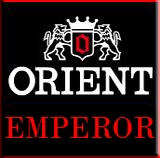|
|
|
LANCIA STRATOS RALLY MONTECARLO 1977
Drivers: MUNARI - MAIGA
1:18 SOLIDO
Year/Anno : 1977
Color/Colore : Livrea Lancia Alitalia
My rating /Mio Voto : 76/100
Value for Money/Rapporto qualità prezzo : 85/100
Original price/Prezzo(2002) : €uro 30
Clicca sul banner in alto per tornare alla Homepage e visionare altri modelli.
Click the banner on the top to return at the Homepage and see the other models of my collection.
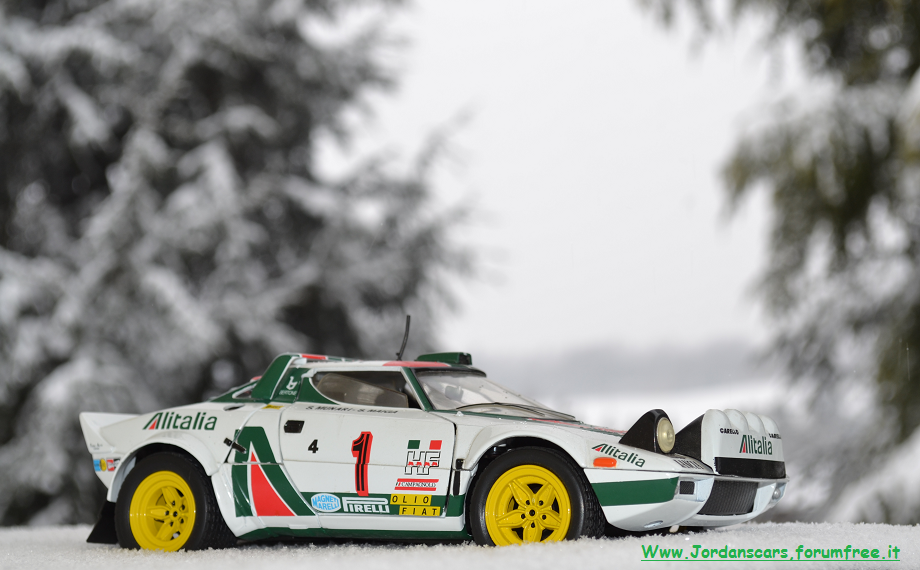
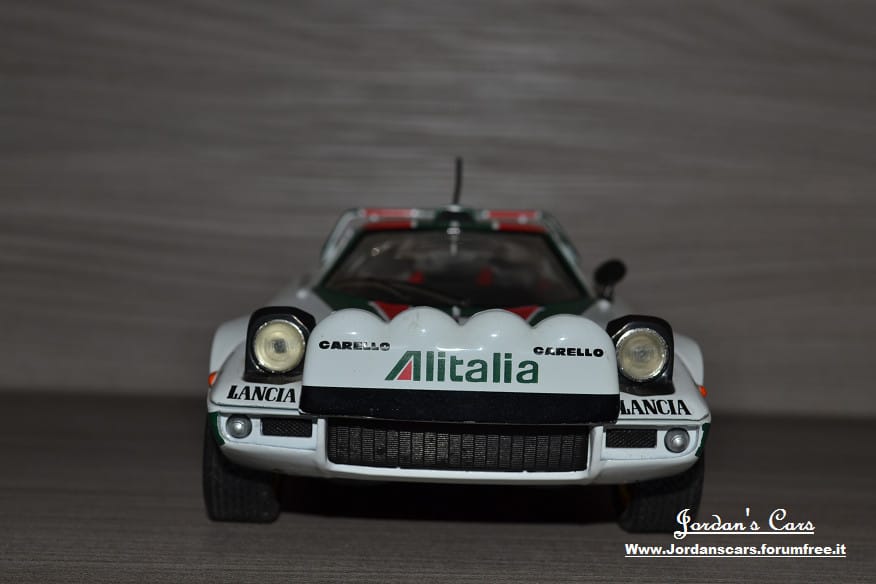
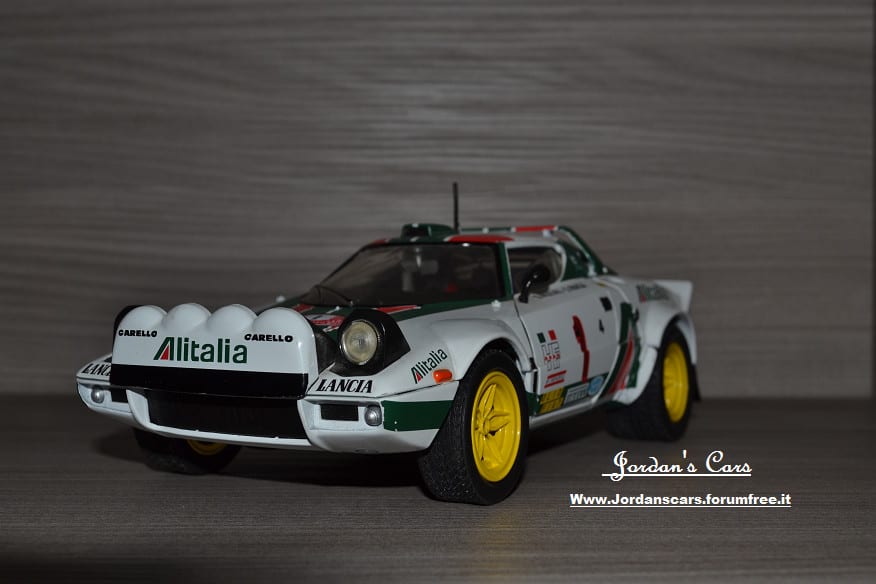
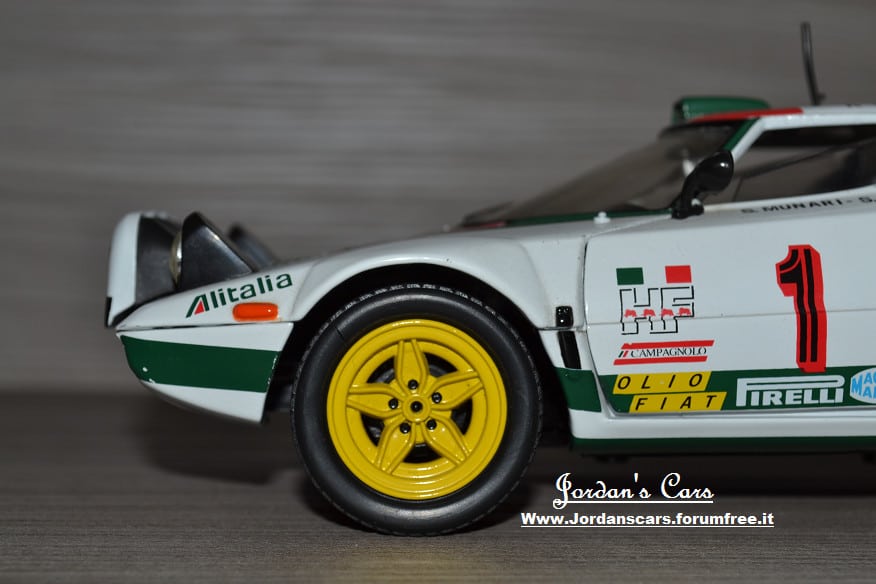
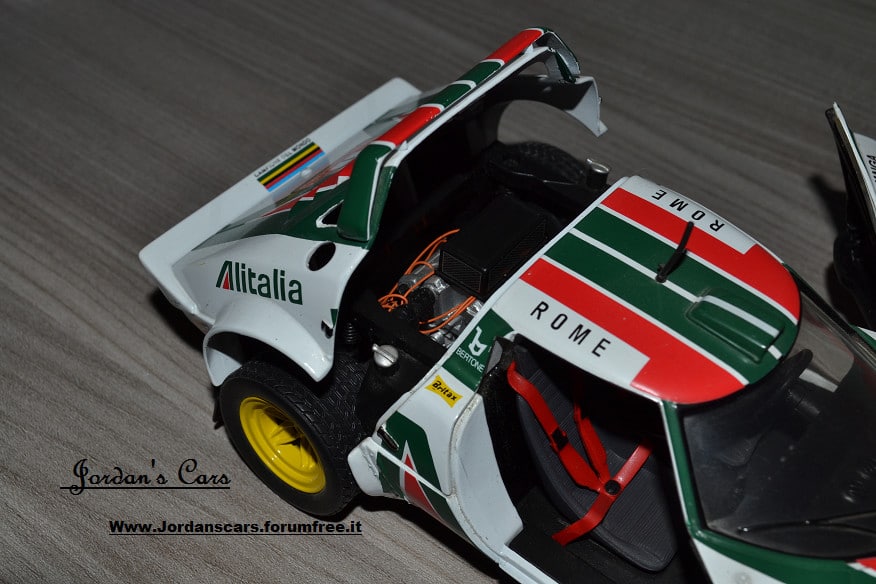
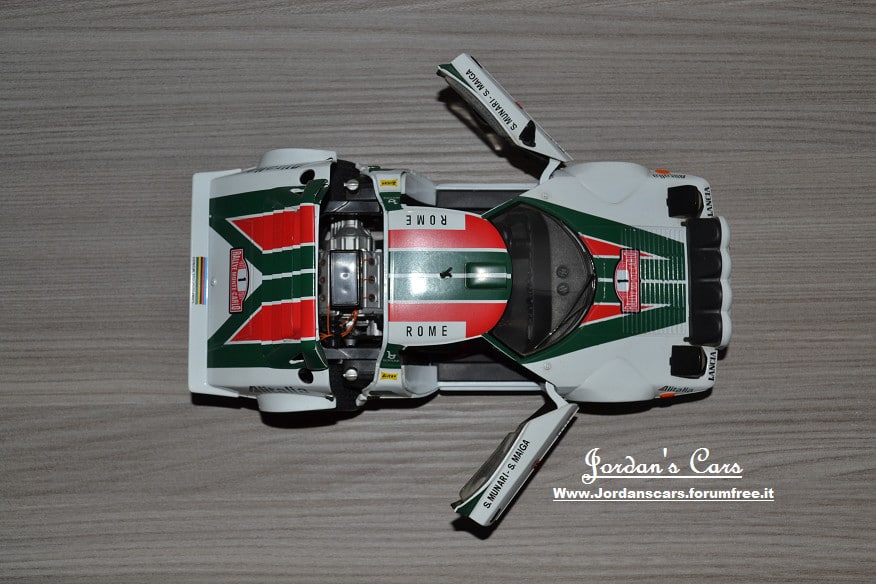
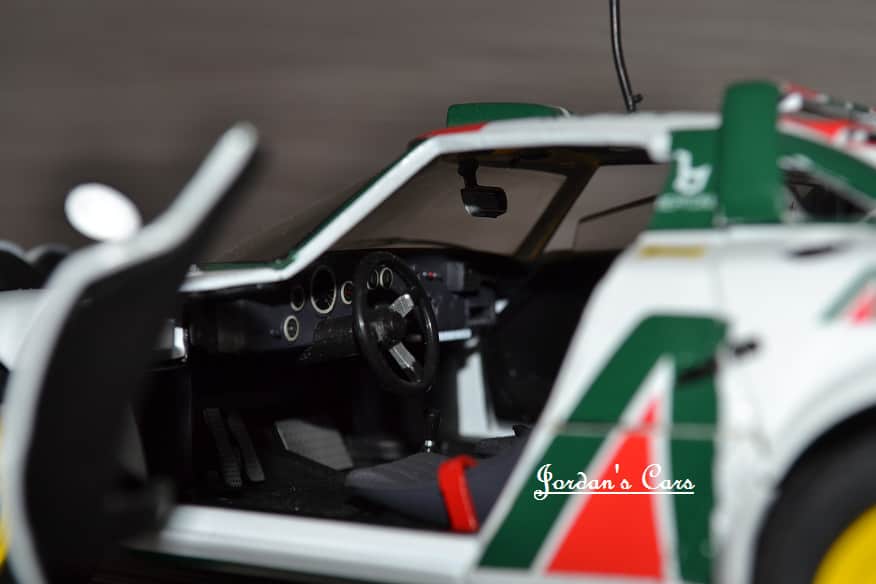
La Lancia Stratos HF è un'automobile con carrozzeria di tipo coupé, prodotta dalla casa automobilistica italiana Lancia dal 1973 al 1975, su disegno di Marcello Gandini per Bertone.
Il nome ufficiale è "Strato's", con l'apostrofo, ma è universalmente nota come "Stratos".
La "Stratos Zero", presentata allora come "Prototipo Zero" era una dream car esposta per la prima volta come prototipo al Salone dell'automobile di Torino del 1970 dalla carrozzeria Bertone; fu presentata come progetto di autovettura sportiva a motore centrale (era quello di una Lancia Fulvia recuperato in una demolizione), di concezione avveniristica per quei tempi. Il design, per quanto non ancora definitivo, dovuto a Marcello Gandini (lo stesso che disegnò auto prestigiose come la Fiat X1/9, la Lamborghini Countach), suscitò subito grande interesse da parte dei vertici della squadra corse della Lancia, guidata da Cesare Fiorio, in cerca della sostituta della Lancia Fulvia nei rally. Per questo motivo nacque la Stratos HF (sigla di High Fidelity), la prima automobile di serie specificamente progettata per i rally.
Nella versione definitiva, sia il motore che la trasmissione erano quelli della Ferrari Dino 246, i quali, abbinati a un telaio monoscocca centrale in acciaio, resero la Stratos un'automobile sportiva molto competitiva. La lenta attività di produzione nello stabilimento Bertone di Grugliasco costrinse la Stratos a gareggiare come Gruppo 5 finché non venne raggiunta la quantità di esemplari prodotti richiesta per l'omologazione in Gruppo 4. In merito, nella dichiarazione a firma di Fiorio, si afferma che al 23 luglio del 1974 ne siano stati costruiti oltre 500 esemplari (515 per la precisione). La veridicità di tale affermazione è stata messa in dubbio da molti; d'altra parte, 17 mesi dopo la soglia minima venne abbassata a 400 esemplari, rendendo così inutile ogni polemica. Conclusa comunque la prima produzione in serie, venne schierata in gara nei rally nell'allora Gruppo 4 e fu per anni la vettura più competitiva: nelle stagioni 1974, 1975 e 1976 diventò Campione del Mondo Rally; ebbe inoltre molti altri successi di prestigio a livello europeo e nei singoli campionati nazionali tra i quali, ovviamente, quello italiano.
L'esordio in gara avvenne nel 1972 al Tour de Corse, dove fu affidata al pilota Sandro Munari[2], il quale dovette ritirarsi per la rottura delle sospensioni posteriori. Ottenne il suo primo successo l'8 settembre del 1973 al Rally Firestone di Spagna con Munari e Mario Mannucci[3]. Ad oggi gli unici rally mondiali che mancano nel palmarès della Stratos sono il Rally RAC e il Safari Rally. Sempre nel 1973 la Stratos venne impiegata nella 57ª Targa Florio, dove giunse seconda pilotata da Munari e Andruet.
Nonostante la Stratos continuasse a essere un'automobile vincente, senza rivali di rilievo, il gruppo Fiat smise di utilizzarla come vettura ufficiale nel Mondiale Rally nel 1977 per rimpiazzarla con la Fiat 131 Abarth Rally: una scelta evidentemente commerciale per promuovere l'immagine del nuovo modello di Mirafiori per le famiglie. La Stratos comunque continuò a gareggiare e a vincere fino al 1982, anno di scadenza dell'omologazione.
Dopo l'adozione della Fiat 131 da parte della squadra corse del gruppo Fiat, furono prodotti ancora altri due esemplari appositamente allestiti per gareggiare come Gruppo 5 Turbo. Uno dei due fu completamente distrutto in un incendio in pista a Zeltweg, l'altro vinse il Giro Automobilistico d'Italia nel 1976, prima di essere spedita in Giappone per partecipare ad un campionato per vetture Silhouette al quale non prese mai parte. Di qui entrò a far parte della collezione Matsuda. Attualmente fa parte della collezione di Chris Hrabalek, il più grande collezionista di Stratos nel mondo, insieme ad altri dieci pezzi unici, inclusa quella del 1977 per il Safari Rally. L'esiguo numero di esemplari costruiti ed il fatto che l'auto fu utilizzata in ogni tipo di gara (persino nei rallycross certamente inadatti a un'automobile da collezione), la rendono infatti uno dei modelli più ricercati dai collezionisti di tutto il mondo.
Il 22 dicembre del 2008 muore Pierugo Gobbato, uno degli ideatori della Stratos e direttore della collaborazione fra Bertone e Lancia.[4] Era figlio dell'Ingegnere Ugo Gobbato (1888-1945), che diresse l'Alfa Romeo impedendo ai nazisti di trasferire la casa automobilistica e i suoi materiali in Germania.
A fine novembre 2010 la Pininfarina ha realizzato una one-off chiamata New Stratos, ispirata alla Lancia Stratos e realizzata a partire dalla base della Ferrari F430 Scuderia. L'auto è stata commissionata dall'imprenditore nel campo automobilistico e collezionista di auto d'epoca Michael Stoschek. Dopo la sua progettazione e costruzione, l'auto ha superato e ottenuto l'omologazione TÜV per poter circolare su strada.
The Lancia Stratos HF (Tipo 829), widely and more simply known as Lancia Stratos, is a sports car and rally car made by Italian car manufacturer Lancia. The HF stands for High Fidelity. It was a very successful rally car, winning the World Rally Championship in 1974, 1975 and 1976.
A Bertone-designed concept car called the Lancia Stratos Zero was shown to the public in 1970, but shares little but the name and mid-engined layout with the Stratos HF version. A new car called the New Stratos was announced in 2010 which was heavily influenced by the design of the original Stratos, but was based on a Ferrari chassis and engine.
Bertone had no previous business with Lancia, who were traditionally linked with Pininfarina, and he wanted to come into conversation with them. Bertone knew that Lancia was looking for a replacement for the ageing Fulvia for use in rally sports and so he designed an eye-catcher to show to Lancia. Bertone used the running gear of the Fulvia Coupé of one of his personal friends and built a running showpiece around it. When Bertone himself appeared at the Lancia factory gates with the Stratos Zero he passed underneath the barrier and got great applause from the Lancia workers. After that a cooperation between Lancia and Bertone was decided to develop a new rally car based on ideas of Bertone’s designer Marcello Gandini who already had designed the Lamborghini Miura and Countach.
Lancia presented the Bertone-designed Lancia Stratos HF prototype at the 1971 Turin Motor Show, a year after the announcement of the Stratos Zero concept car. The prototype Stratos HF (Chassis 1240) was fluorescent red in colour and featured a distinctive crescent-shaped-wrap-around windshield providing maximum forward visibility with almost no rear visibility. The prototype had three different engines in its early development life: the Lancia Fulvia engine, the Lancia Beta engine and finally for the 1971 public announcement, the mid-mounted Dino Ferrari V6 producing 190 hp (140 kW). The use of the Dino V6 was planned right from the beginning of the project, but Enzo Ferrari was reluctant to sign off the use of this engine in a car he saw as a competitor to his own Dino V6. After the production of the Dino car had ended the "Commendatore" (a popular nickname for Enzo Ferrari) agreed on delivering the engines for the Stratos, and Lancia then suddenly received 500 units.
The Stratos was a very successful rally car during the 1970s and early 1980s. It started a new era in rallying as it was the first car designed from scratch for this kind of competition. The three leading men behind the entire rallying project were Lancia team manager Cesare Fiorio, British racer/engineer Mike Parkes and factory rally driver Sandro Munari with Bertone's Designer Marcello Gandini taking a very personal interest in designing and producing the bodywork.
Lancia did extensive testing with the Stratos and raced the car in several racing events where Group 5 prototypes were allowed during the 1972 and 1973 seasons. Production of the 500 cars required for homologation in Group 4 commenced in 1973 and the Stratos was homologated for the 1974 World Rally Championship season. The Ferrari Dino V6 engine was phased out in 1974, but 500 engines among the last built were delivered to Lancia. Production ended in 1975 when it was thought that only 492 were made (for the 1976 season, the Group 4 production requirement was reduced to 400 in 24 months). Manufacturer of the car was Bertone in Turin, with final assembly by Lancia at the Chivasso plant. Powered by the Dino 2.4 L V6 engine that was also fitted to the rallying versions, but in a lower state of tune, it resulted in a power output of 190 hp (140 kW), giving the road car a 0–100 km/h time of 6.8 seconds, and a top speed of 232 km/h (144 mph). The car was sold as the Lancia Stratos HF Stradale.
The Stratos weighed between 900 and 950 kilograms, depending on configuration. Power output was around 275 hp (205 kW) for the original 12 valve version and 320 hp (240 kW) for the 24 valve version. Beginning with the 1976 season the 24 valve heads were banned from competition for being non-standard. Even with this perceived power deficit the Stratos was the car to beat in competition and when it did not suffer an accident or premature transmission failure (of the latter there were many) it had great chances to win. Despite the fact that the Stratos was never intended to be a race car, there were two Group 5 racing cars built with 560 hp (420 kW), using a single KKK turbocharger.
The car won the 1974, 1975 and 1976 championship titles in the hands of Sandro Munari and Björn Waldegård, and might have gone on to win more had not internal politics within the Fiat group placed rallying responsibility on the Fiat 131 Abarths. As well as victories on the 1975, 1976 and 1977 Monte Carlo Rally, all courtesy of Munari, the Stratos won the event with the private Chardonnet Team as late as 1979.[6]
Without support from Fiat, and despite new regulations that restricted engine power, the car would remain a serious competitor and proved able to beat works cars in several occasions when entered by an experienced private team with a talented driver. The last victory of the Stratos was in 1981, at the Tour de Corse Automobile, another World Rally Championship event, with a victory by longtime Stratos privateer Bernard Darniche.
When the Fiat group favoured the Fiat 131 for rallying Lancia also built two Group 5 turbocharged 'silhouette' Stratos for closed-track endurance racing. These cars failed against the Porsche 935s on closed tracks but proved successful in hybrid events. While they failed in the Tour de France Automobile, one of these cars won the 1976 Giro d'Italia Automobilistico, an Italian counterpart of the Tour de France Automobile. One of the cars was destroyed in Zeltweg, when it caught fire due to overheating problems. The last surviving car would win the Giro d'Italia event again before it was shipped to Japan to compete in the Fuji Speedway based Formula Silhouette series, which was never raced. The car would then be sold and reside in the Matsuda Collection before then being sold to the renowned collector of Stratos', Christian Hrabalek, a car designer and the founder of Fenomenon Ltd, who has the largest Lancia Stratos Collection in the world, 11 unique Lancia Stratos cars, including the fluorescent red 1971 factory prototype and the 1977 Safari Rally car.[11] His interest in the car led to the development of the Fenomenon Stratos in 2005. The Stratos also gained limited success in 24 Hours of Le Mans, with a car, driven by Christine Dacremont and Lella Lombardi, finishing 20th in 1976.
Modelli correlati / Related models:
LANCIA STRATOS HF RALLY SANREMO 1974 ---> https://jordanscars.forumfree.it/?t=71113456
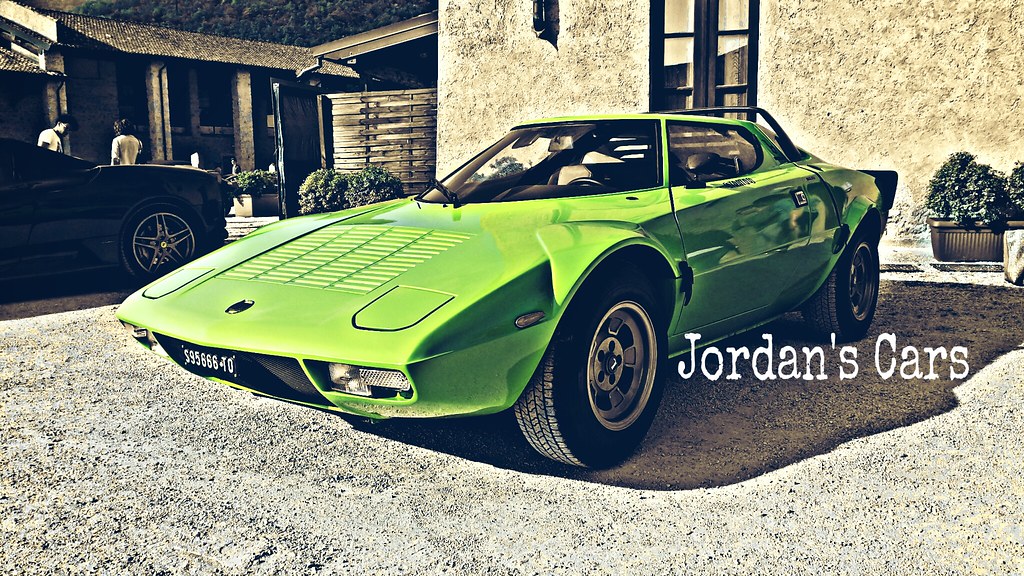
Edited by xJORDANx - 4/3/2018, 21:15
|
|










 .
.





